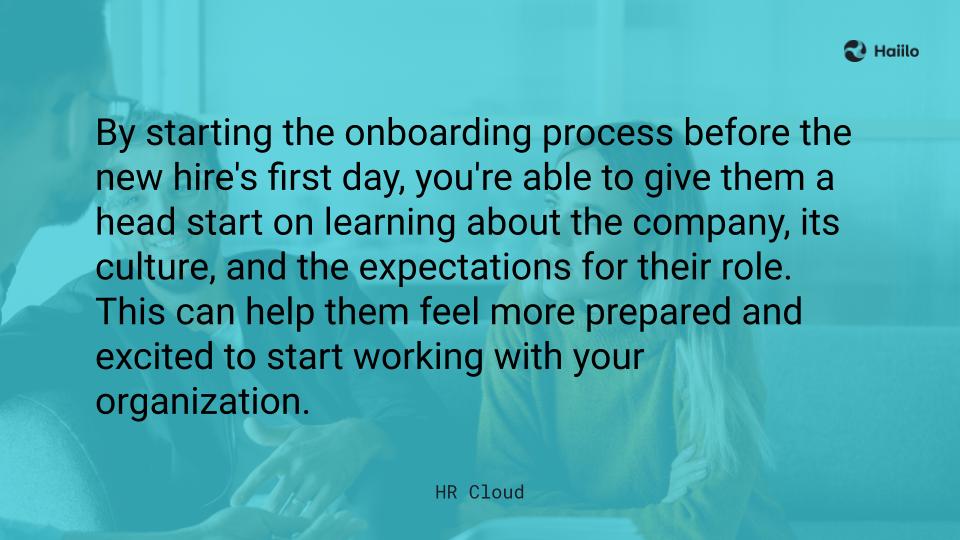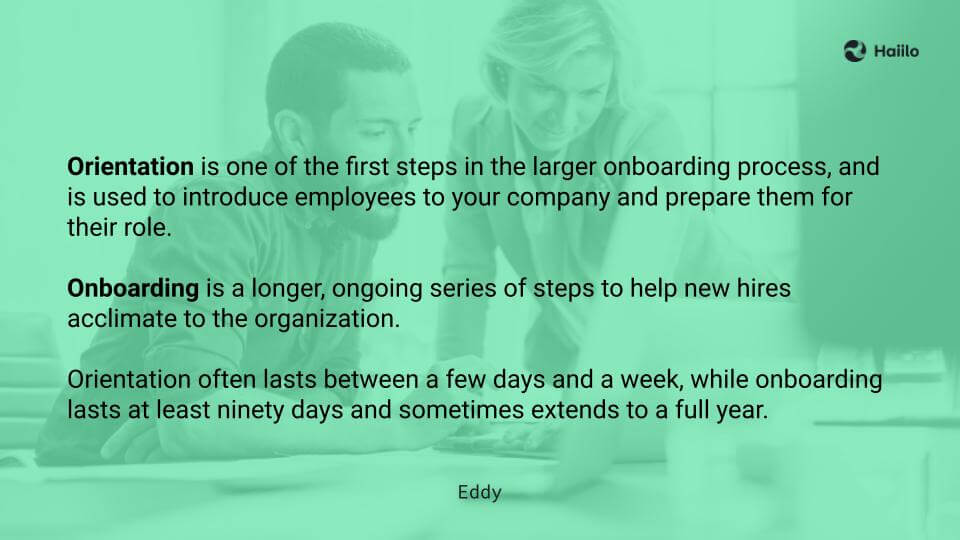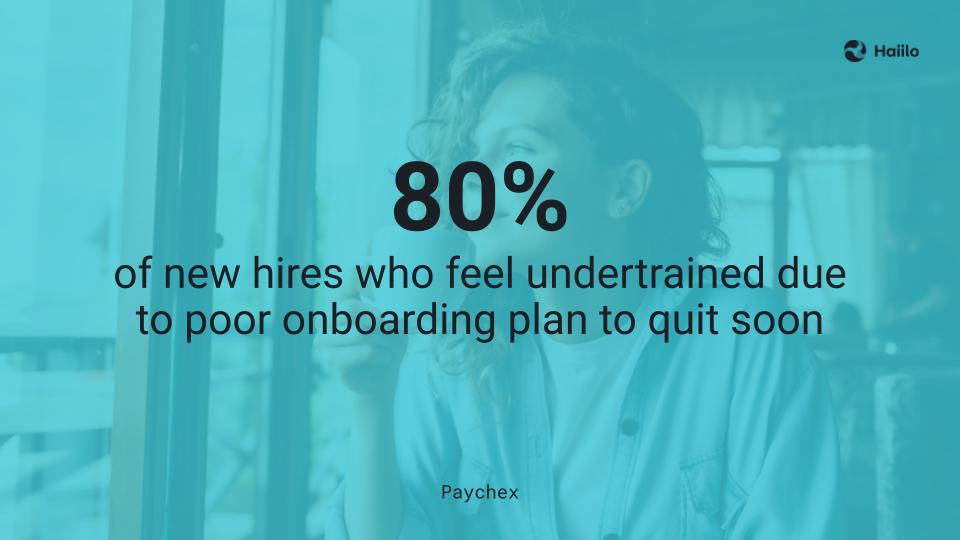Effective employee onboarding is essential for creating engagement and ensuring long-term retention. When new hires join an organization, they should feel welcomed, supported, and prepared to take on their new role. When done right, onboarding helps new hires feel well-prepared and integrated, setting them up for success. Designing a thorough onboarding program is a continuous process, and it plays an important role in retention and overall employee satisfaction.
Studies have shown that an effective employee onboarding experience reduces turnover by an outstanding 82%, yet only 12% of US employees believe that their company has a satisfactory onboarding process. New hires absorb everything during the first year: company culture, their role, team dynamics, and more.
A robust onboarding program should include everything from creating connections with new colleagues to completing paperwork. To achieve this, organizations should focus on the essential elements of onboarding while being thorough yet efficient. One widely recognized framework is the 5 C’s of Onboarding.
- The Five Cs of Onboarding
- 8 Proven Onboarding Strategies
- 1. Start with Pre-Boarding
- 2. Create a Welcoming Environment
- 3. Diversify the Experience
- 4. Involve Colleagues at Different Levels
- 5. Cover the Basics
- 6. Centralize New Employee Resources
- 7. Set Clear Expectations and Provide Growth Opportunities
- 8. Follow Up and Keep it Going
- Conclusion
Haiilo makes it easier to onboard and integrate new hires into your company.
The 5 Cs of Onboarding
Building a custom onboarding program that fits your organization can make all the difference. The 5 Cs framework provides a comprehensive approach to ensure that all critical aspects of onboarding are addressed. What are the 5 Cs, and how can they benefit the employee onboarding experience?
- Clarity: New hires should develop an understanding of their roles, the company, policies, and expected milestones. This clarity sets the stage for a strong foundation, leading to happier employees and better retention.
- Compliance: This includes ensuring that employees understand policies and processes and have completed any necessary paperwork. Compliance encompasses the necessary legal actions that a new hire should take to ensure they are familiar with company policies.
- Culture: Your organization’s mission, vision, values, and history tell a story of who you are. Introducing these concepts to new hires helps shape their understanding of the company culture and creates a sense of belonging.
- Connection: Relationships are critical to the new hire experience. Joining a new organization can be intimidating, but facilitating team meetings, assigning a buddy or mentor, and introducing new hires to colleagues support relationship building and help them integrate.
- Check-In: Providing regular opportunities for new employees to ask questions, clarify, and address concerns will help them feel heard and more comfortable in their new environment. Look for ways to collect feedback to continuously improve the onboarding experience.
Implementing a framework like the 5 Cs helps create a structured and supportive environment that can lead to higher satisfaction, reduced turnover, and better performance. Designing a robust onboarding program is a continuous process, not a one-time event, and requires careful planning and execution.
💡Learn about the benefits of Employee Experience Platforms
8 Proven Onboarding Strategies
With a basic understanding of the 5 Cs, let’s translate these concepts into practical steps. In this section, we’ll examine some proven strategies that offer actionable insights that can help organizations create a comprehensive and impactful onboarding experience.
1. Start with Pre-Boarding
There’s no need to hold off on the onboarding experience. Engaging new hires before their official start date helps them feel prepared and excited about joining the team and takes away some of those first-day jitters.
Consider sharing a schedule for day one or week one in advance so that they know what to expect, who they’ll be meeting with, and what they’ll be doing. It’s also helpful to provide new hires with a checklist of things that need to be done within their first x amount of days so that they stay on track and feel organized. This ensures that nothing is overlooked and establishes clarity.
It’s also important to make sure that the team is prepared for the new hire’s first day. Clean up their desk area so they enter an organized workspace, send a welcome email so that colleagues are familiar with the new addition to the team, and set meetings up on their calendars. Have all necessary materials and resources ready for the new hire’s first day to make a strong first impression.

2. Create a Welcoming Environment
Starting something new in an unfamiliar environment can cause a lot of stress and anxiety. Start by greeting them at the entrance on their first day so that they feel comfortable walking into their new office.
In addition to some of the ideas shared in the section above, you might place some company swag on their desk to give them something to show off. You might also take them to lunch or to grab a coffee and introduce them to new colleagues who sit nearby.
Simple steps can go a long way in helping a new employee feel safe and comfortable, and that will have a long-lasting positive impact.
🧐 Check out 9 Efficient Ways to Break Down Silos in Your Organization
3. Diversify the Experience
Offer various learning avenues, such as virtual sessions, recorded videos, and interactive activities, to cater to different learning styles. Incorporating different learning methods prevents the onboarding program from feeling stale or boring, supports various learning preferences, and creates opportunities for new hires to engage with and interact with new colleagues. Studies show that about 70% of learners are multi-modal, meaning they can learn from various methods. When you incorporate different styles into your onboarding approach, you’ll be helping new hires integrate into their new role more effectively.
You should also pace the onboarding process so that new hires can manage it without feeling overwhelmed, allowing them to absorb information effectively. Everyone learns at their own speed, and it’s important to find a balance between thoroughness and efficiency while also giving new hires some ownership over completing their tasks.

4. Involve Colleagues of Different Levels
There are many different ways to engage colleagues of various levels in a new hire’s onboarding process. You might assign a buddy or mentor, organize get-to-know-you meetings, or design a social event to help new hires meet new people.
In a larger organization, it’s important for new employees to become familiar with the type of work that is taking place at different levels of the organization and the type of roles within the company. When you connect new hires with colleagues of all kinds, it helps them develop a more holistic understanding of how the company operates.
5. Cover the Basics
Consider compartmentalizing onboarding in a way that works for your organization. This could look like:
- Company Orientation: Provide an overview of the company, its values and mission, culture, and expectations. Share the organization’s history, introduce executive leaders, and review policies and procedures. Remember that orientation is the first step of the onboarding process and is used to provide an understanding of the company and prepare them to be successful in their role.
- Office and Technology Orientation: One of the most important things to do for in-office training is to show new hires where things are and how to use the tools they have access to. Offer a building tour, demonstrate how to connect to and use printers, and show them where they can locate office supplies.
- Role-specific Training: This type of onboarding will be more personalized than some other components and will focus on the employee’s specific position. It might include thorough job training, setting them up with the necessary tools, and supporting their growth by setting milestones and performance goals.
- Departmental or Unit Orientation: Depending on your organization’s size or structure, it may be valuable to help new hires develop an understanding of their specific unit or department. This is where you might share departmental roles and expectations and how you might collaborate with others across the organization. This approach can help new employees meet colleagues and managers and establish relationships.
Your organization may need to include fewer or more elements, but the most important thing is developing a comprehensive plan that encompasses the 5 Cs that we reviewed earlier.
🪜More on onboarding: 6 Benefits of Employee Onboarding Done Right

6. Centralize New Employee Resources
Studies show that organizations with strong knowledge management practices experience a 15-30% improvement in new hire productivity. When new employee resources are stored in one location, you eliminate the guessing game of where they can find the information they need and ensure that all new hires have access to it. This reduces time spent looking for answers and empowers new hires to be self-sufficient.
Consider creating a new employee resource page on your intranet that outlines what new hires need to do and know and includes documents and links. Larger organizations with robust onboarding programs could create a website dedicated to onboarding. The site could house resources, onboarding schedules, and checklists to ensure a consistent onboarding experience.
7. Set Clear Expectations and Provide Growth Opportunities
A great way to prepare a new hire for success is to provide them with a clear onboarding plan that includes milestones and expectations. This allows them to understand what they need to do within a certain timeframe and gives them something to work towards.
Setting them with performance goals is another way to support their growth in their new role. Goal setting eliminates vague expectations and turns them into achievable milestones that employees and supervisors can track and celebrate. Include the new hire in determining what their goals should be so that they feel a sense of ownership over them, and provide them with sample goals to help them get started. Sharing a framework for SMART goals can also streamline the process and help them design goals that will provide both of you with the same expectations.

8. Follow Up and Keep it Going
One of the biggest mistakes organizations make in onboarding is not following up. Following up provides an opportunity to check in with new hires to ensure they feel supported and are developing an understanding of their role. Studies show that 80% of new hires who feel undertrained due to poor onboarding plan to quit soon, compared to only 7% who feel they’ve had an adequate onboarding experience. Regular check-ins allow you to address issues while also collecting feedback, enabling the company to measure effectiveness and identify gaps in the onboarding program, paving the way for continuous improvement.
Determine a cadence that works for your company, such as at the end of the first week and then at their 30, 60, and 90-day milestones. The first few weeks at the company are the most influential, and with regular check-ins, you can foster engagement and demonstrate support. If any issues arise, the company can address them promptly, redirecting any negative first impressions and creating a positive overall onboarding experience.

Conclusion
Employees with a strong onboarding experience are 2.6x more likely to feel satisfied at work, underscoring the importance of getting this right. Effective employee onboarding is a critical process that sets the foundation for success and long-term engagement. By incorporating the 5 Cs – Clarity, Compliance, Culture, Connection, and Checking In – organizations can design a structured and supportive onboarding experience that reduces turnover and boosts employee satisfaction.
Organizations implementing these proven practices, from pre-boarding to continuous follow-up, help new employees feel welcomed, supported, and prepared for their roles. Investing the time and resources needed to design a comprehensive onboarding program benefits the organization overall.
Remember, onboarding is a journey, not a one-time event. It’s about continually improving and adapting to meet the needs of your employees. By investing in a thoughtful onboarding process, you’re investing in the future of your organization.
So, take these tips and start revamping your onboarding program. Your new hires—and your entire team—will thank you for it.
➡️ Keep Reading: What is Employee Journey Mapping and How to Create One









